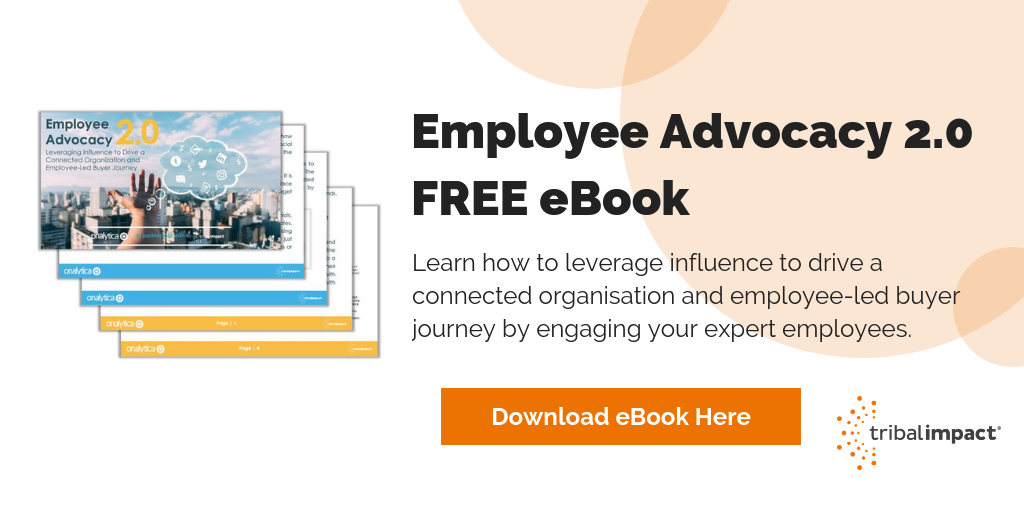The modern buyer wants to be educated and informed, rather than sold to. Our ability to research and choose is hugely amplified in today’s digital society and, for this reason, the way that companies win business and influence ‘browsers’, has changed.
Employee-led marketing is fast becoming the most popular way to spread a brand message. The continual high levels of noise and interaction across social media, however, combined with the old adage that if a thing’s worth doing, it’s worth doing well, means that firms need to focus on quality, rather than quantity, if they’re going to make the marketing impact they desire.
In the recent report, Employee Advocacy 2.0, co-authored by Onalytica and Tribal Impact, Jay Baer, Founder of Convince & Convert, is quoted as saying ‘content is the raw material of influence’.
That’s the ethos of employee-led marketing in a nutshell. But why has content become a make or break element of employee advocacy, what constitutes good quality and what should we be watching out for?
Read on for our 4 reasons employee-led marketing can’t survive without quality content.
1. Trust
Deliberately at the top of our list, trust and authenticity are the basis behind successful business these days. The 2018 Edelman Trust Barometer report states “Gresham’s Law, based on the18th-century observation that debased currency drives out the good, is now evident in the realm of information, with fake news crowding out real news.”
For ‘fake news’, read engineered brand content, contrived messaging or even good, old-fashioned advertising. Content is a key enabler of trust and conversation and, as such, its success in terms of engaging your audience can be measured by its authenticity. Audiences are far more likely to engage with content written by brand influencers who are peers, than with content generated by the brand itself.
2. Currency
Think cachet rather than cash. It’s well-documented that people share content on social media that increases their credibility, whether that’s because it’s surprising, unusual, funny, or little-known. Companies that create good quality content for their employee advocacy programme – ie, that with ‘shareability’ – will be more successful in encouraging their people to become brand influencers by sharing this content.
Dull, obviously salesy, content is unlikely to bring any value to anyone’s social feeds and will therefore, probably, be ignored. Employee advocacy is the main driving force for a brand to get its message out into the digital world and the content aligned with a brand advocacy programme must be of good quality.
3. Alignment
Your sales and marketing teams have, traditionally, been involved with customer audiences at different stages of the sales process. With the sales funnel now looking more like an egg-timer, sales and marketing need to align their messaging and work together to ensure potential customers are captured and nurtured throughout their buying research and decision-making process. With the wrong sort of content, this activity is virtually impossible to get right.
Harking back to the idea of trust and authenticity, content needs to speak to your audience and show that the brand has listened. Today, prospective buyers are much more likely to be converted by content that innovates and solves their problems as opposed to content which simply pumps out a branding message. There’s a huge focus here on walking the walk: if a brand wants to be known for caring, customer-focused behaviours, they need to prove these qualities. What better way than to be producing content which shows you are listening to the digital conversations and that you care about solving problems with your product or service?
4. Interest
Social Media is a noisy place in which to do business. Brand advocacy is now a 24/7 activity, with content being pushed out left, right and centre. As consumers, we barely have downtime and its easy to wonder how we can see the wood for the trees. Brian Fanzo, CEO and Founder of iSocialFanz, has the answer: “Ultimately, the content cutting through the noise is the content that is relatable, real and honorable”, he says, adding that it’s high time we moved away from creating content for content’s sake.
For consumers, it’s so easy to research and become and informed buyer these days, that a poorly designed brand advocacy program will be instantly recognisable as insincere. According to LinkedIn, 75% of B2B buyers use social media to support purchase decisions and combined employee networks are typically 10 times the size of the corporate account. It stands to reason, therefore, that good quality, authentic and useful content, distributed through the employee advocacy platform, will have far more reach and impact than any other.


